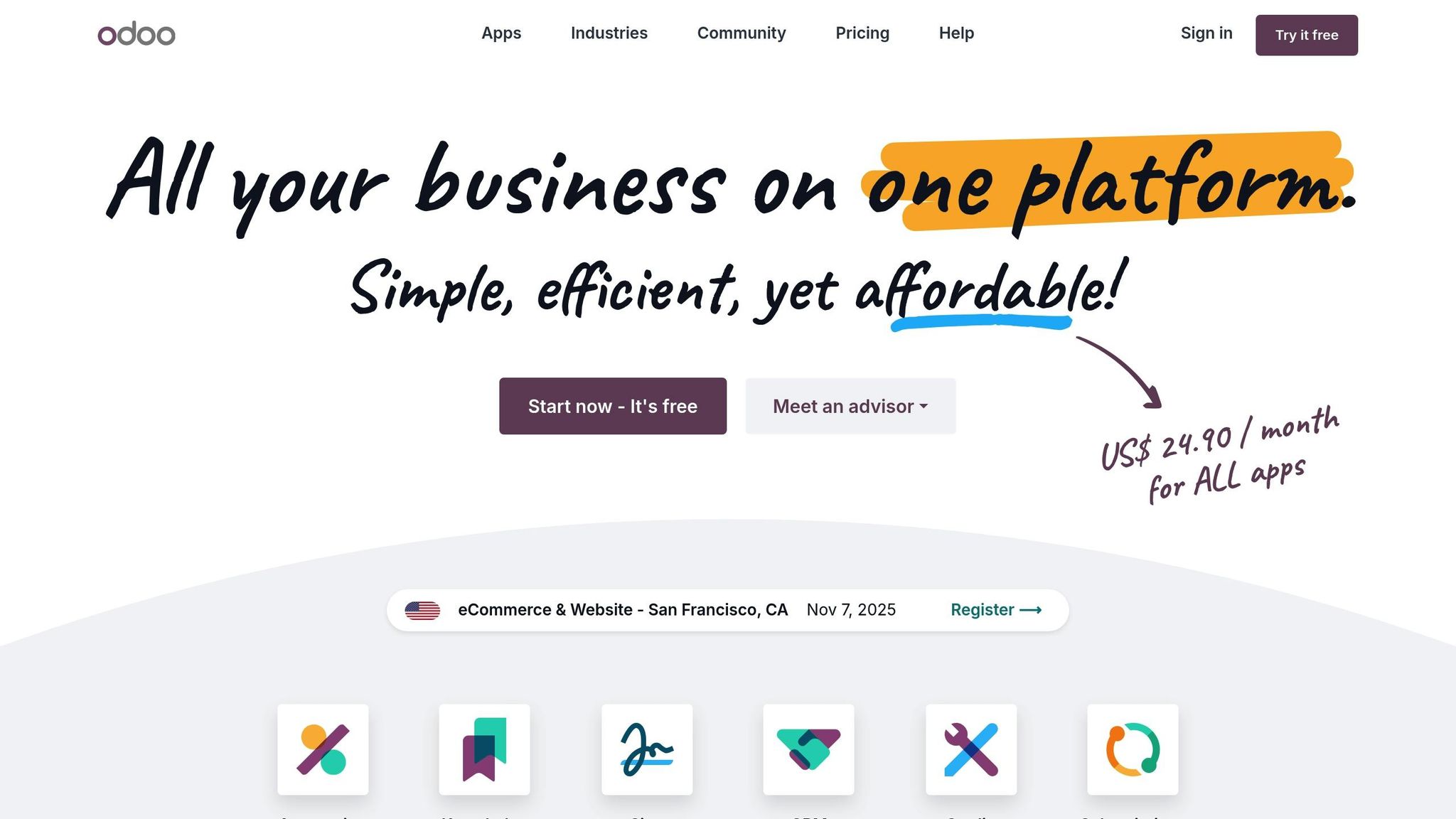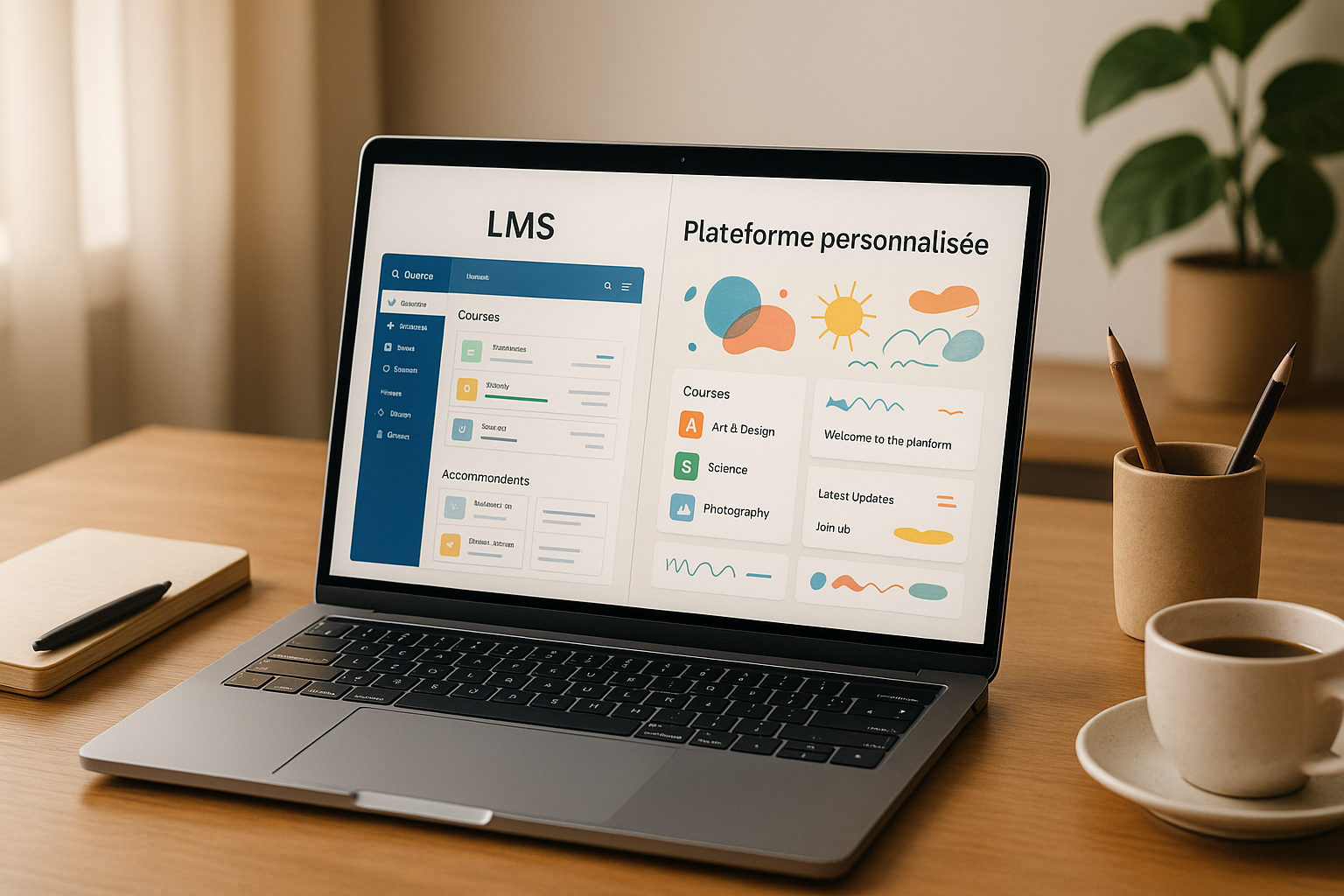LMS vs custom platforms: which choice for education?
LMS vs custom platforms: what choice for education?
Are you hesitating between a standard LMS (like Moodle) and a custom educational platform? Here are the key points to help you decide:
- LMS: Ready-to-use solution, quick to deploy, and less expensive (CHF 2–10/user/month). Ideal for standard needs and quick deployment.
- Custom platform: Offers a tailored experience, integrates seamlessly with existing systems, and meets specific needs. Requires a significant initial investment (CHF 20,000–200,000+).
Swiss context: Multilingualism (French, German, Italian, English) and strict standards (GDPR, data protection) influence the choice. LMS like Moodle are popular, but a custom platform may better meet local requirements.
Quick comparison
| Criterion | LMS | Custom platform |
|---|---|---|
| Initial cost | CHF 2–10/user/month | CHF 20,000–200,000+ |
| Customization | Limited | Very high |
| Deployment | Quick (few weeks) | Long (several months) |
| Swiss compliance | Variable | Customized |
| Multilingual support | Basic | Advanced and localized |
Conclusion: If you are looking for a quick and cost-effective solution, an LMS is sufficient. For specific needs and deep local integration, a custom platform remains the best choice. Make sure to evaluate your current and future needs before deciding.
How to create an e-learning platform with Odoo? (French tutorial)

What is an LMS platform?
An LMS (Learning Management System) is a centralized software designed to create, manage, deliver, and track training and learning programs. These platforms allow for standardizing education, whether formal or professional.
Most LMS operate on a SaaS (Software as a Service) model, offering quick deployment without requiring significant technical investments. This cloud-based model provides ready-to-use solutions with pre-built modules and integrated technical support.
In Switzerland, Moodle remains a reference due to its flexibility and multilingual support, thus meeting local linguistic requirements. Unlike custom solutions, LMS adopt a standardized approach. Here is an overview of the main features, advantages, and limitations of these platforms.
Key features of LMS platforms
LMS platforms cover the entire learning process with a range of essential features:
- Course management: These tools allow for creating, organizing, and scheduling educational content in a structured manner.
- Progress tracking: Through real-time monitoring, it is possible to track learners' progress, complemented by detailed reports on participation and results.
- Integrated assessment: Platforms include automated quizzes, online graded assignments, and standardized grading systems.
- Communication tools: Internal messaging, forums, and collaborative spaces enhance the learning experience.
- Compliance management: In Switzerland, where regulatory obligations are strict, these tools help track mandatory training and automatically generate necessary reports.
- Scalability and integration: LMS can accommodate thousands of users and connect to other systems (HR tools, video conferencing, analytics platforms) via APIs.
Advantages of LMS platforms
LMS offer several major advantages:
- Reduced costs and quick deployment: Unlike custom solutions that require months of development, LMS can be operational in a few weeks.
- Regulatory compliance: These platforms ensure complete traceability of training and produce audit-appropriate reports, an essential aspect in the Swiss context.
- Standardization of processes: They ensure a consistent experience for all users while simplifying administrative management.
- Increased accessibility: Available 24/7 on all devices, they allow for flexible learning tailored to individual needs.
Limitations of LMS platforms
Despite their many advantages, LMS also have drawbacks:
- Limited customization: These platforms struggle to adapt to specific workflows or branding needs, limiting their flexibility for tailored learning paths.
- Generic interfaces: Users accustomed to modern digital experiences may find these interfaces frustrating.
- Technical expertise required: For open-source solutions like Moodle, configuration may require specific technical skills, necessitating organizations to train their teams or engage external providers.
- Complex integration: Difficulties in connecting LMS with existing systems can hinder their adoption.
What is a custom educational platform?
A custom educational platform is designed to meet the specific needs of an institution or company. It offers complete freedom in designing the user experience, while seamlessly integrating with existing systems and adapting to internal processes.
In Switzerland, where quality expectations and multilingual requirements are particularly high, these platforms allow for creating learning experiences aligned with local needs. Their flexible architecture adapts to organizational changes while ensuring full control over the solution and data. This represents a key advantage in ensuring digital sovereignty. These technical and functional characteristics make them a solid alternative that we will compare to LMS in the following section.
Key features of custom platforms
-
Customized learning paths
These platforms allow for creating educational paths tailored to individual learners' needs and goals, far beyond the automated recommendations of traditional LMS. -
Specialized integration
Seamless connection with business tools, ERP systems, or talent management platforms to form a harmonious digital ecosystem. -
Adjusted branding
Each interaction reflects the visual identity and values of the organization through extensive customization. -
Integrated content creation tools
With intuitive interfaces and tools, sometimes assisted by artificial intelligence, it is easy to produce educational content without advanced technical expertise. -
Adaptable architecture
Content delivery methods adjust to the chosen pedagogical approaches, whether interactive tutorials, multimedia content, or other immersive formats.
These features clearly differentiate custom platforms from standardized solutions.
Advantages of custom platforms
Opting for a custom platform offers several notable benefits:
-
Better user engagement
Integration into the work environment facilitates access to content in a professional context, thereby increasing participation. - According to a 2024 report, the adoption of custom learning platforms led to a 30% increase in learner engagement and a 25% improvement in course completion rates compared to generic LMS[5].
-
High adaptability
The platform can evolve with needs: adding new features, adjusting workflows, or integrating emerging technologies. -
Durable return on investment
The absence of recurring license fees and full system control reduce dependence on third-party providers. -
Competitive advantage
A unique learning experience that is hard to replicate with standardized solutions. -
Advanced multilingual support
Beyond translation, these platforms integrate content and approaches tailored to different linguistic regions and their specificities.
These advantages make custom platforms a strategic choice for organizations with specific needs.
Limitations of custom platforms
Despite their many advantages, these solutions also present challenges:
-
High initial cost
Designing and developing a custom solution requires a significant investment. -
Extended development timelines
Implementation can take several months or longer, which can slow down deployment. -
Complex maintenance
Updates, security patches, and functional evolutions require dedicated technical resources. -
Technical expertise dependency
Managing these platforms requires specific skills, creating a dependency on development teams.
A survey conducted by Docebo in 2023 reveals that 72% of training professionals believe that custom integrations and tailored workflows are essential for the success of digital learning initiatives[5].
For Swiss organizations, it is crucial to collaborate with experienced partners in creating custom educational solutions. Working with a specialized agency, like , can simplify the management of technical challenges, budget constraints, and local needs, while facilitating comparison with standard LMS.
sbb-itb-454261f
LMS vs custom platforms: direct comparison
Choosing between a standard LMS and a custom educational platform requires careful examination of essential criteria. In Switzerland, these criteria take on a particular dimension due to local needs and regulatory requirements.
Initial costs are often the first element to consider. Standard LMS offer monthly subscriptions ranging from CHF 2 to CHF 10 per user, with enterprise packages starting at around CHF 500 per month. In contrast, custom platforms require a much larger initial investment, ranging from CHF 20,000 to CHF 200,000, depending on the project's complexity and required integrations.
Flexibility is another determining criterion. Standard LMS offer limited options based on existing modules and plugins. In contrast, a custom platform can be entirely designed to meet the specific workflows and pedagogical approaches of the organization.
In terms of user experience, the differences are significant. Standard LMS often offer a generic interface, sometimes unengaging. Custom platforms, on the other hand, allow for the development of a tailored, multilingual UX designed to maximize user engagement while meeting local expectations.
Integration with Swiss local systems (such as administrative tools, payment systems, or reporting) is also a point of distinction. While standard LMS offer APIs, these may be limited or require additional adjustments. A custom platform, on the other hand, is designed to seamlessly integrate with the existing infrastructure.
Comparative table: LMS vs custom platforms
| Criterion | Standard LMS | Custom Platform |
|---|---|---|
| Initial cost | CHF 2–10/user/month | CHF 20,000–200,000+ |
| Recurring costs | Monthly or annual subscription | Custom maintenance |
| Flexibility | Limited to available options | Very high, according to needs |
| User experience | Standardized, sometimes rigid | Customized and brand-adapted |
| Integration | Available APIs, sometimes limited | Deep integration on demand |
| Multilingual support | Variable, often basic | Native, optimized for local needs |
| Scalability | Good (SaaS solutions) | Depends on chosen architecture |
| Compliance | Generally certified (GDPR) | Customized, according to requirements |
| Implementation time | Quick (few weeks) | Longer (several months) |
Legal compliance is another crucial aspect, especially for Swiss institutions. Some standard LMS, often hosted internationally, do not always meet Swiss data protection standards or GDPR. A custom platform, on the other hand, can be specifically developed to ensure compliance, including data residency and accessibility.
In summary, a standard LMS is ideal for quick implementation and controlled costs, while a custom platform shines with its flexibility and alignment with specific needs. These elements are part of a broader analysis, as mentioned earlier.
How to choose the right solution
Once the advantages and disadvantages of both approaches have been analyzed, it is time to define the criteria that will guide your choice. Opting between a standard LMS and a custom solution requires a precise evaluation of the specific needs of your educational project.
Key decision factors
The size of your organization plays a crucial role. Large institutions, with over 1,000 users, often benefit from robust LMS like Moodle, which has over 300 million users worldwide [3]. Conversely, smaller structures may prefer custom platforms, offering total flexibility and tailored experiences [2].
Internal technical resources are also a determining factor. SaaS-based LMS require few technical skills, as hosting and updates are managed by the provider [2]. In contrast, developing and maintaining a custom platform requires advanced skills and often collaboration with experts or specialized agencies [4].
Customization is another decisive factor. If your organization needs specific workflows, unique branding, or internal system integration, a custom platform will be more suitable. Standard LMS, while effective, are limited by their architecture and available extensions [3].
